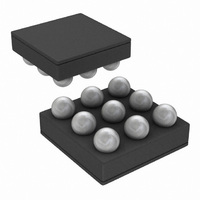LM4898ITL/NOPB National Semiconductor, LM4898ITL/NOPB Datasheet - Page 11

LM4898ITL/NOPB
Manufacturer Part Number
LM4898ITL/NOPB
Description
IC AMP AUDIO PWR 1.4W MONO 9USMD
Manufacturer
National Semiconductor
Series
Boomer®r
Type
Class ABr
Datasheet
1.LM4898LDNOPB.pdf
(17 pages)
Specifications of LM4898ITL/NOPB
Output Type
1-Channel (Mono)
Max Output Power X Channels @ Load
1.4W x 1 @ 4 Ohm
Voltage - Supply
2.4 V ~ 5.5 V
Features
Depop, Differential Inputs, Shutdown, Thermal Protection
Mounting Type
Surface Mount
Package / Case
9-MicroSMD
Operational Class
Class-AB
Audio Amplifier Output Configuration
1-Channel Mono
Output Power (typ)
1x1@8OhmW
Audio Amplifier Function
Speaker
Total Harmonic Distortion
0.05@8Ohm@400mW%
Single Supply Voltage (typ)
3/5V
Dual Supply Voltage (typ)
Not RequiredV
Power Supply Requirement
Single
Rail/rail I/o Type
No
Power Supply Rejection Ratio
90dB
Single Supply Voltage (min)
2.4V
Single Supply Voltage (max)
5.5V
Dual Supply Voltage (min)
Not RequiredV
Dual Supply Voltage (max)
Not RequiredV
Operating Temp Range
-40C to 85C
Operating Temperature Classification
Industrial
Mounting
Surface Mount
Pin Count
9
Package Type
uSMD
For Use With
LM4898ITLBD - BOARD EVALUATION LM4898ITL
Lead Free Status / RoHS Status
Lead free / RoHS Compliant
Other names
LM4898ITL
LM4898ITL
LM4898ITL
Typical Performance Characteristics
Non-LD Specific Characteristics
Application Information
DIFFERENTIAL AMPLIFIER EXPLANATION
The LM4898 is a fully differential audio amplifier that fea-
tures differential input and output stages. Internally this is
accomplished by two circuits: a differential amplifier and a
common mode feedback amplifier that adjusts the output
voltages so that the average value remains V
setting the differential gain, the amplifier can be considered
to have two "halves". Each half uses an input and feedback
resistor (R
(see Figure 1). With R
at -R
It is extremely important to match the input resistors to each
other, as well as the feedback resistors to each other for best
amplifier performance. See the Proper Selection of External
Components section for more information. A differential am-
plifier works in a manner where the difference between the
f
/R
i
for each half. This results in a differential gain of
i
1 and R
PSRR vs Common Mode Voltage
V
DD
f
1) to set its respective closed-loop gain
CMRR vs Frequency
= 5V, R
i
1 = R
A
VD
V
DD
i
L
= -R
2 and R
= 8Ω, 200mV
= 5V
f
/R
i
f
1 = R
f
2, the gain is set
pp
DD
200737F2
200737E8
/2. When
(Continued)
(1)
11
two input signals is amplified. In most applications, this
would require input signals that are 180˚ out of phase with
each other. The LM4898 can be used, however, as a single
ended input amplifier while still retaining its fully differential
benefits. In fact, completely unrelated signals may be placed
on the input pins. The LM4898 simply amplifies the differ-
ence between them.
All of these applications, either single-ended or fully differ-
ential, provide what is known as a "bridged mode" output
(bridge-tied-load, BTL). This results in output signals at Vo1
and Vo2 that are 180˚ out of phase with respect to each
other. Bridged mode operation is different from the single-
ended amplifier configuration that connects the load be-
tween the amplifier output and ground. A bridged amplifier
design has distinct advantages over the single-ended con-
figuration: it provides differential drive to the load, thus dou-
bling maximum possible output swing for a specific supply
voltage. Four times the output power is possible compared
with a single-ended amplifier under the same conditions.
This increase in attainable output power assumes that the
V
PSRR vs Common Mode Voltage
DD
V
= 3V, R
DD
CMRR vs Frequency
= 3V, R
L
= 8Ω, 217Hz, 200mV
L
= 8Ω, 200mV
pp
pp
200737F4
200737F0
www.national.com







